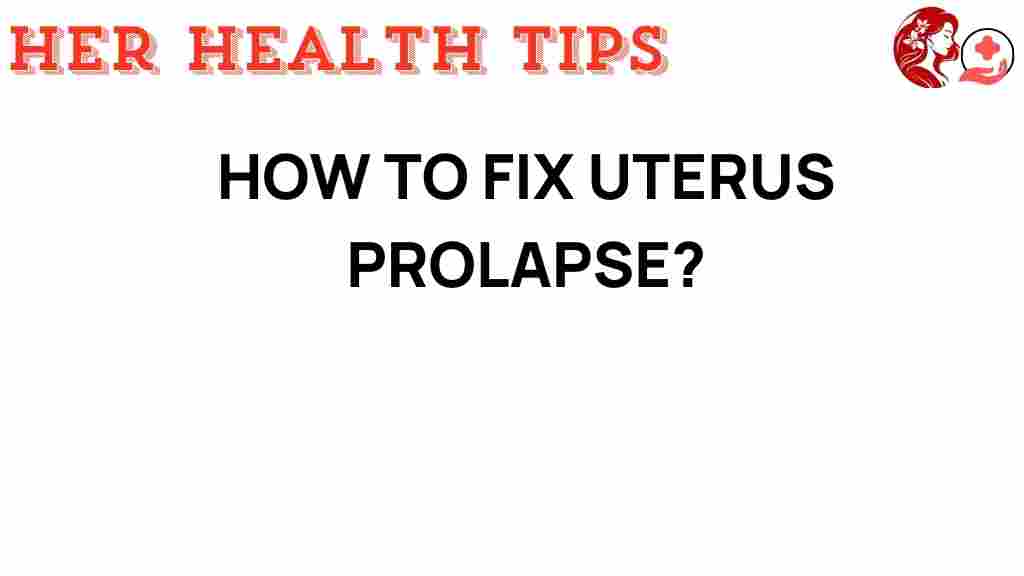Unraveling the Secrets: How to Fix Uterus Prolapse
Uterus prolapse is a condition that affects many women, often leading to discomfort and a reduction in quality of life. Understanding the causes, symptoms, and effective treatment options is crucial for anyone dealing with this issue. In this comprehensive guide, we will delve into what uterus prolapse is, explore various treatment options, discuss pelvic health, and provide recovery strategies that can improve women’s wellness.
Understanding Uterus Prolapse
Uterus prolapse occurs when the uterus descends into the vaginal canal due to weakened pelvic muscles and ligaments. This condition can happen after childbirth, during menopause, or due to other factors that weaken the pelvic support structures.
- Causes of Uterus Prolapse:
- Childbirth and pregnancy
- Menopause and hormonal changes
- Obesity
- Chronic cough or constipation
- Heavy lifting or strenuous exercise
- Symptoms of Uterus Prolapse:
- Feeling of pressure or fullness in the pelvic area
- Visible bulge in the vagina
- Pain during intercourse
- Urinary incontinence
- Difficulty emptying the bladder or bowels
Treatment Options for Uterus Prolapse
When seeking treatment for uterus prolapse, it is essential to consult with a healthcare professional for personalized medical advice. Below are the common treatment options available.
1. Lifestyle Changes
Making certain lifestyle changes can significantly improve pelvic health and alleviate symptoms of uterus prolapse:
- Weight Management: Maintaining a healthy weight can reduce pressure on the pelvic floor.
- Regular Exercise: Engaging in pelvic floor exercises, such as Kegel exercises, can strengthen the pelvic muscles.
- Avoiding Heavy Lifting: Reducing the frequency of heavy lifting can help prevent further strain on the pelvic area.
2. Pelvic Floor Therapy
Working with a physical therapist specializing in pelvic health can provide tailored exercises and techniques to strengthen pelvic muscles and improve support for the uterus.
3. Pessaries
Pessaries are devices inserted into the vagina to support the uterus. They can be an effective non-surgical option for women who prefer to avoid surgery.
4. Surgical Options
In cases where conservative treatments do not alleviate symptoms, surgical intervention may be necessary. Surgical options include:
- Uterine Suspension: This procedure repositions the uterus and supports it with stitches or mesh.
- Hysterectomy: Removal of the uterus may be recommended in severe cases.
Recovery Strategies After Treatment
Recovery from treatment for uterus prolapse can vary depending on the chosen method. Here are some key recovery strategies:
- Follow Medical Advice: Always adhere to your doctor’s post-treatment guidelines for a smooth recovery.
- Gradual Return to Activities: Start with light activities and gradually increase intensity as recommended.
- Continued Pelvic Floor Exercises: Keep practicing Kegel exercises to maintain muscle strength.
Support Systems for Women’s Wellness
Having a strong support system is vital for women experiencing uterus prolapse. Consider the following:
- Support Groups: Joining a support group can provide emotional support and practical advice from others facing similar challenges.
- Family and Friends: Open communication with loved ones can help alleviate feelings of isolation.
- Professional Counseling: Seeking therapy can be beneficial for coping with the emotional aspects of uterus prolapse.
Troubleshooting Tips for Uterus Prolapse
If you experience worsening symptoms or new issues after treatment for uterus prolapse, consider the following troubleshooting tips:
- Track Symptoms: Keep a journal of symptoms to discuss with your healthcare provider.
- Reevaluate Lifestyle Changes: Assess whether your lifestyle modifications are effective and make adjustments as needed.
- Consult Your Doctor: Do not hesitate to reach out for medical advice if you have concerns about your recovery.
Conclusion
Uterus prolapse is a manageable condition with various treatment options available. By focusing on lifestyle changes, seeking medical advice, and utilizing support systems, women can enhance their pelvic health and overall wellness. Whether you choose conservative treatments or surgical options, understanding your body and advocating for your health is essential. Remember, recovery is a journey, and with the right strategies in place, you can regain control of your pelvic health.
For more information about women’s health and wellness, visit this resource. If you’re looking for peer support, consider reaching out to local organizations or online communities dedicated to women’s health.
This article is in the category Reproductive and created by HerHealthTips Team
